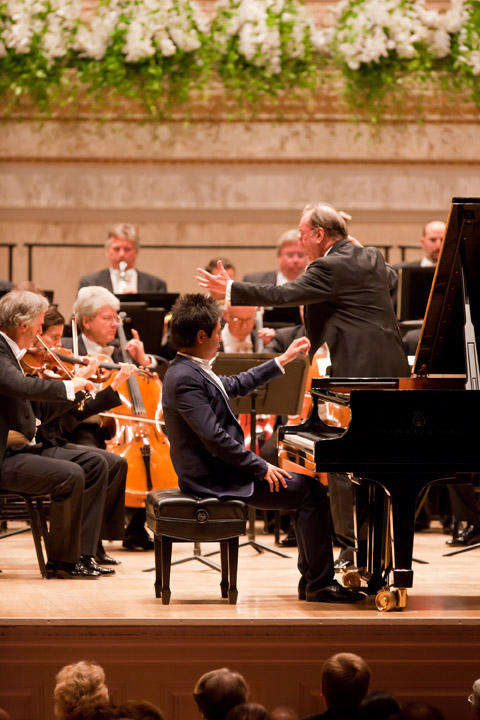Vienna Philharmonic Orchestra at The Carnegie Hall Opening Gala
Vienna Philharmonic Orchestra Nikolaus Harnoncourt, conductor Lang Lang, piano Carnegie Hall Opening Gala, New York, NY September 29, 2010
Carnegie Hall opens its 2010-2011 season with a gala benefit concert featuring the Vienna Philharmonic Orchestra led by Nikolaus Harnoncourt in Stern Auditorium/Perelman Stage. The all-Beethoven program includes Symphony No. 7 in A Major as well as the Piano Concerto No. 1 in C Major, featuring guest soloist Lang Lang. Photo Credit: Chris Lee
To launch its new season, Carnegie Hall invited the Vienna Philharmonic for four concerts, the first two conducted by Nikolaus Harnoncourt, the last two by Gustavo Dudamel. The Opening Night Gala also celebrated the Orchestra’s 101st performance at Carnegie Hall, giving it an especially festive air.
As is often the case with Gala concerts, the program was very conventional: Beethoven’s Seventh Symphony and first Piano Concerto. The only surprise was that the 80-year-old German-born, Austrian-based maestro had personally selected the 28-year-old Chinese pianist Lang Lang as his soloist, an odd choice that seemed based on an attraction of opposites. But as soon as the music started, it was clear that it was grounded instead in mutual respect and pleasure in working together.
Harnoncourt is best known for his pioneering work with period-instrument groups, but he has gradually broadened his activities, conducting symphony orchestras and exploring the romantic literature. Using no podium or baton, he exhibited a degree of physical energy and emotional intensity that a man half his age might envy. His Beethoven interpretations seemed to follow traditional lines: respect for structure, dynamics and phrasing; restrained tempi, steady rhythm, and expressiveness without sentimentality. The only exception to this moderation was his penchant for excessive contrast between loud and soft, and for going from whisper to explosion with startling abruptness. In the most forceful moments, the strings sounded positively scratchy, the brass raucous – a distinct departure from the Vienna Philharmonic’s famously pure, mellow tone. Moreover, in Beethoven’s frequent descending two-note figures, Harnoncourt exaggerated the phrasing by dropping the second note to near-inaudibility. The performance’s most pervasive flaw was a lack of orchestral balance, with the winds, especially the brass, consistently overpowering the strings. Though this often happens with today’s orchestras, it came as a surprise here. Generally, though, the playing was as fine as always; intonation, ensemble, and precision were impeccable; every instrumental timbre stood out yet blended into the whole. Concertmaster Rainer Honeck (whose brother Manfred recently became Music Director of the Pittsburgh Symphony), seemed unusually active, leading with vigorous, assertive motions of his whole body.
Lang Lang played the Concerto beautifully, with charm and a courtly grace free of the exaggerations which sometimes mark his playing. His legato sang; he brought out inner voices usually ignored; his tone was lovely at every dynamic level and full of subtle colors and nuances. Rhythmically flexible but not erratic, the music was sprightly and rippling in the fast movements , simple and expressive in the slow one. Though he reserved his by now legendary virtuosity only for the cadenza, he received a standing ovation; four eager little girls delivered gorgeous bouquets, which he presented to the three women who have cracked the orchestra’s all-male code, tossing the forth into the wind section. Then came the encore: the Finale of Prokofiev’s Seventh Piano Sonata, a marathon of racing, pounding fingers so wild as to be virtually unrecognizable.
